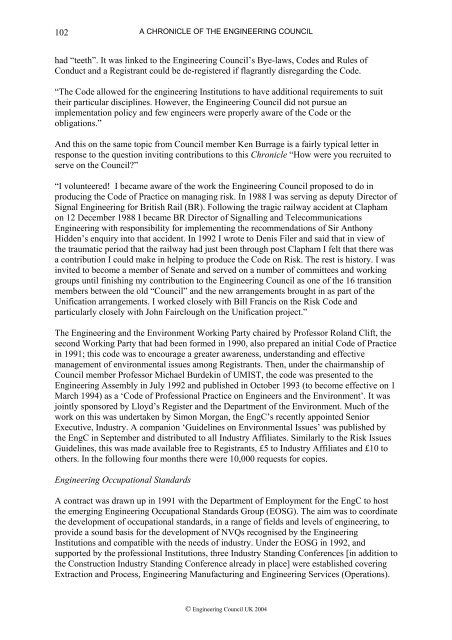An Engine for Change - A Chronicle of the Engineering Council
An Engine for Change - A Chronicle of the Engineering Council
An Engine for Change - A Chronicle of the Engineering Council
Create successful ePaper yourself
Turn your PDF publications into a flip-book with our unique Google optimized e-Paper software.
102A CHRONICLE OF THE ENGINEERING COUNCILhad “teeth”. It was linked to <strong>the</strong> <strong>Engine</strong>ering <strong>Council</strong>’s Bye-laws, Codes and Rules <strong>of</strong>Conduct and a Registrant could be de-registered if flagrantly disregarding <strong>the</strong> Code.“The Code allowed <strong>for</strong> <strong>the</strong> engineering Institutions to have additional requirements to suit<strong>the</strong>ir particular disciplines. However, <strong>the</strong> <strong>Engine</strong>ering <strong>Council</strong> did not pursue animplementation policy and few engineers were properly aware <strong>of</strong> <strong>the</strong> Code or <strong>the</strong>obligations.”<strong>An</strong>d this on <strong>the</strong> same topic from <strong>Council</strong> member Ken Burrage is a fairly typical letter inresponse to <strong>the</strong> question inviting contributions to this <strong>Chronicle</strong> “How were you recruited toserve on <strong>the</strong> <strong>Council</strong>?”“I volunteered! I became aware <strong>of</strong> <strong>the</strong> work <strong>the</strong> <strong>Engine</strong>ering <strong>Council</strong> proposed to do inproducing <strong>the</strong> Code <strong>of</strong> Practice on managing risk. In 1988 I was serving as deputy Director <strong>of</strong>Signal <strong>Engine</strong>ering <strong>for</strong> British Rail (BR). Following <strong>the</strong> tragic railway accident at Claphamon 12 December 1988 I became BR Director <strong>of</strong> Signalling and Telecommunications<strong>Engine</strong>ering with responsibility <strong>for</strong> implementing <strong>the</strong> recommendations <strong>of</strong> Sir <strong>An</strong>thonyHidden’s enquiry into that accident. In 1992 I wrote to Denis Filer and said that in view <strong>of</strong><strong>the</strong> traumatic period that <strong>the</strong> railway had just been through post Clapham I felt that <strong>the</strong>re wasa contribution I could make in helping to produce <strong>the</strong> Code on Risk. The rest is history. I wasinvited to become a member <strong>of</strong> Senate and served on a number <strong>of</strong> committees and workinggroups until finishing my contribution to <strong>the</strong> <strong>Engine</strong>ering <strong>Council</strong> as one <strong>of</strong> <strong>the</strong> 16 transitionmembers between <strong>the</strong> old “<strong>Council</strong>” and <strong>the</strong> new arrangements brought in as part <strong>of</strong> <strong>the</strong>Unification arrangements. I worked closely with Bill Francis on <strong>the</strong> Risk Code andparticularly closely with John Fairclough on <strong>the</strong> Unification project.”The <strong>Engine</strong>ering and <strong>the</strong> Environment Working Party chaired by Pr<strong>of</strong>essor Roland Clift, <strong>the</strong>second Working Party that had been <strong>for</strong>med in 1990, also prepared an initial Code <strong>of</strong> Practicein 1991; this code was to encourage a greater awareness, understanding and effectivemanagement <strong>of</strong> environmental issues among Registrants. Then, under <strong>the</strong> chairmanship <strong>of</strong><strong>Council</strong> member Pr<strong>of</strong>essor Michael Burdekin <strong>of</strong> UMIST, <strong>the</strong> code was presented to <strong>the</strong><strong>Engine</strong>ering Assembly in July 1992 and published in October 1993 (to become effective on 1March 1994) as a ‘Code <strong>of</strong> Pr<strong>of</strong>essional Practice on <strong>Engine</strong>ers and <strong>the</strong> Environment’. It wasjointly sponsored by Lloyd’s Register and <strong>the</strong> Department <strong>of</strong> <strong>the</strong> Environment. Much <strong>of</strong> <strong>the</strong>work on this was undertaken by Simon Morgan, <strong>the</strong> EngC’s recently appointed SeniorExecutive, Industry. A companion ‘Guidelines on Environmental Issues’ was published by<strong>the</strong> EngC in September and distributed to all Industry Affiliates. Similarly to <strong>the</strong> Risk IssuesGuidelines, this was made available free to Registrants, £5 to Industry Affiliates and £10 too<strong>the</strong>rs. In <strong>the</strong> following four months <strong>the</strong>re were 10,000 requests <strong>for</strong> copies.<strong>Engine</strong>ering Occupational StandardsA contract was drawn up in 1991 with <strong>the</strong> Department <strong>of</strong> Employment <strong>for</strong> <strong>the</strong> EngC to host<strong>the</strong> emerging <strong>Engine</strong>ering Occupational Standards Group (EOSG). The aim was to coordinate<strong>the</strong> development <strong>of</strong> occupational standards, in a range <strong>of</strong> fields and levels <strong>of</strong> engineering, toprovide a sound basis <strong>for</strong> <strong>the</strong> development <strong>of</strong> NVQs recognised by <strong>the</strong> <strong>Engine</strong>eringInstitutions and compatible with <strong>the</strong> needs <strong>of</strong> industry. Under <strong>the</strong> EOSG in 1992, andsupported by <strong>the</strong> pr<strong>of</strong>essional Institutions, three Industry Standing Conferences [in addition to<strong>the</strong> Construction Industry Standing Conference already in place] were established coveringExtraction and Process, <strong>Engine</strong>ering Manufacturing and <strong>Engine</strong>ering Services (Operations).© <strong>Engine</strong>ering <strong>Council</strong> UK 2004
















